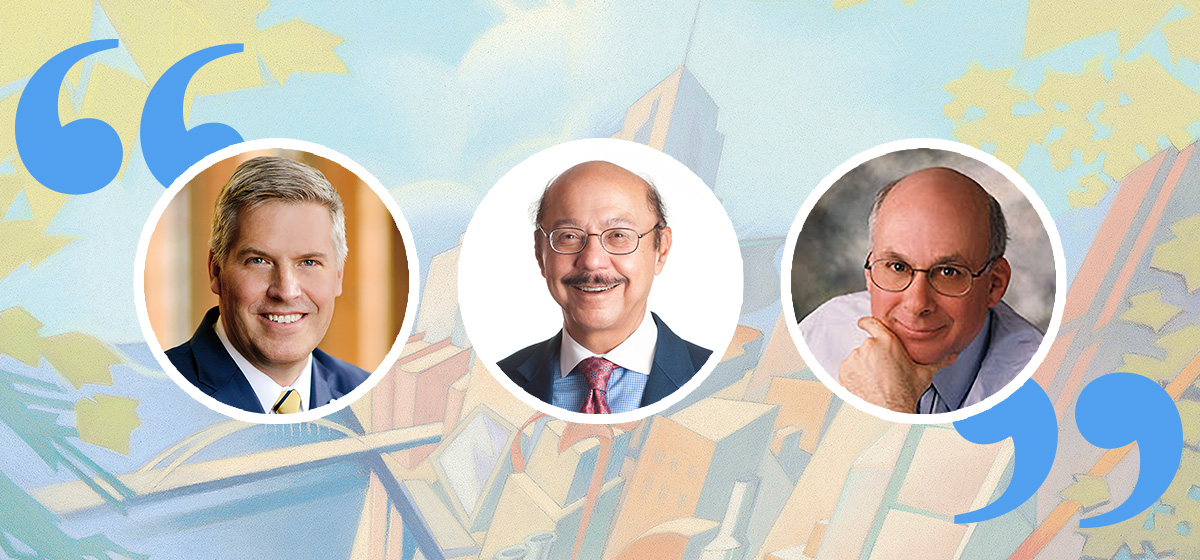Bold Action Needed: Patrick Gallagher, Sunil Wadhwani, Dennis Unkovic

At a time when the Pittsburgh region is continuing to lose population and has been seeing regional job losses the past few months, we asked a group of regional leaders to respond, in 200 words or less, to this question: What action do we need to take to create the kind of growth, vitality and dynamism that will stem our population loss and catalyze a strong future?
Patrick Gallagher—Chancellor, University of Pittsburgh
Pittsburgh is blessed with many of the ingredients needed to be economically competitive and primed for growth. It’s a wonderful place to live and raise a family. Our universities supply talent and entrepreneurial energy. Our workforce is skilled and famously industrious. Major markets sit nearby—in every direction. And we enjoy a rare abundance of natural and cultural riches.
With so many strengths on record, it’s reasonable to wonder: Why aren’t we growing?
The short answer is that we lack a strategy that articulates why we want to grow and what steps we must take to evolve. We’re like a team full of the most talented players—but without a coach, a game plan, or a sense of teamwork. As a result, we’re losing against “less talented” regions that are leveraging a playbook and cleverly collaborating.
Growth, especially equitable growth, is no happy accident. It requires a clear path forward and asks each partner to be aligned and assiduous in strengthening economic opportunities for all. How intentionally we engage in this work will impact whether or not Pittsburgh grows—and if this growth will benefit the many or merely the few.
Sunil Wadhwani—President, Wadhwani Impact Trust; Founder, Wadhwani Institute for Artificial Intelligence; and Founder and Chair, Mastech Corporation
Let’s make Pittsburgh’s next Renaissance a people Renaissance, built on innovation and inclusion.
I grew up in India and came to Pittsburgh in the mid-1970s to study. I’ve witnessed this region go from the devastation following the shutdown of our steel mills to become one of the most livable cities in the United States. But even as we’ve become more livable, we’ve failed to reverse the population loss precipitated by the collapse of steel.
Here are two ideas to reverse this trend:
First, let’s invest in our region’s human capital by raising a billion-dollar Pittsburgh People’s Prosperity Fund. Over the next 10 years, this will give us an additional $100 million a year to invest in our students and citizens for educational and job opportunities; entrepreneurs to create and grow companies; and to attract new people and businesses to our region. We can accelerate the creation of our jobs of the future and equip our citizens with the skills to leverage those jobs. Raising a billion dollars is an ambitious target, but—with the commitment of our corporate, civic and political leaders—we can do it!
Second, let’s commit ourselves to building a more diverse and inclusive region. Not many of us are aware that over half of all young workers entering the U.S. workforce today are diverse—African American, Hispanic, Native American or Asian. Hence any region that wants to grow has to be effective at attracting and retaining such workers.
Unfortunately, our Pittsburgh region is the least diverse of the major metros in the country. This lack of diversity threatens the supply of workers ready to fill current and future job openings, and diminishes our appeal to businesses looking to relocate or expand here. Let’s set a goal of increasing the diversity level of our workforce—currently only 11 percent—to that of our peer regions—who are at 25 percent—by 2030.
Pittsburgh’s First Renaissance cleaned our air and our rivers. Our Second Renaissance cleaned up Downtown and built our regional infrastructure. Let’s make our next renaissance a People Renaissance that embraces innovation and inclusion!
Dennis Unkovic—Partner, Meyer Unkovic & Scott
Size matters when it comes to cities. In this global economy, any city with a small population base is underestimated and ignored even if it is home to leading universities, renowned healthcare, world-class corporations and financial institutions, and winning sports teams. Because of its minuscule footprint, Pittsburgh will remain a second-tier city unless it takes decisive steps forward. The only solution is to merge the City of Pittsburgh (population 302,000) and Allegheny County (population 1.22 million) into a single metropolitan unit. During the 1960s, Toronto lived in the shadow of Montreal. After merging small towns, today Toronto boasts 2.73 million residents—a million more than Montreal. Mayor Peduto and County Executive Fitzgerald need to set aside their egos and fully support the public referendum needed to create a new metropolitan area and thus a greater Pittsburgh. The world has changed. Small local governments are outmoded and too expensive because of duplicative services. It is time for the Allegheny Conference to return to its roots and serve as an agent for change. Let this be the decade when we take bold action to accomplish great things. We need to embrace the future and place Pittsburgh in the forefront of global leadership.





